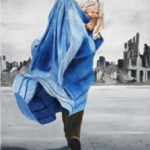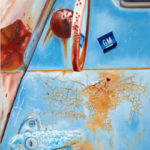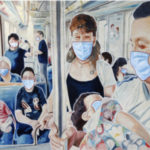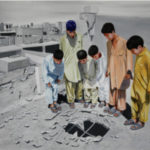
For a few years now, Jean-Jacques Venturini has turned to a new style: essentially figurative painting, without being conventional. He develops an innate sense of detail throughout his works. At the heart of his paintings, warmth, inhabited silence, and hidden characters intertwine through contrasts of shadow and light and effects of materials.
Nice-Premium: You are regularly inspired by current events. Why did you come up with this idea?
Jean-Jacques Venturini: The idea is not new. My generation was largely influenced by the “Nouvelle figuration” movement. It’s an artistic movement that established the transition between the hegemonic abstraction of the 1950s and a so-called “narrative” figuration that emerged in 1965 to celebrate the Thirty Glorious Years.
It is a figurative painting that is the French equivalent of American Pop Art with a more pronounced political engagement.
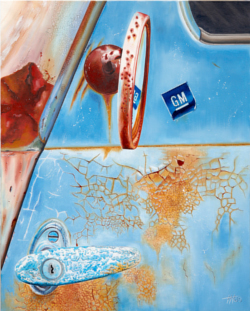
JJV: I don’t think my painting is dark, but I’m not trying to infuse it with gaiety either.
My painting can express a sense of revolt, anger, or sorrow and poetically and colorfully address heavy subjects such as the wearing of a burka, children from the wars in Pakistan or Iraq, the dramatic crash of an Air Bus, the pandemic…
It’s a side way of capturing the news, which today spreads within minutes via Twitter or the Internet before moving on to another topic even faster.
I have an attraction for the media image retrieved from current events. I can also draw inspiration from specific contributions from cinema, comics, or technical drawing.
Nice-Premium: Information rarely takes place close to home. How do you go about finding inspiration?
JJV: My first inspiration comes from the eyes and the heart, generally through television, photographic, or cinematic news, which inundates us with images every day.
The internet is an inexhaustible source of “models,” it has entered my studio.
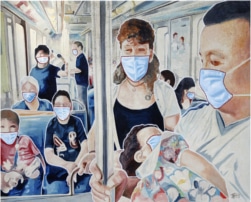
JJV: Certainly, being an artist in one’s history is essentially about temporality, it’s about speaking of events and the passing of time. I am interested in scenes of daily life and mythologies (political, social, moral). My figurative paintings, deliberately cold and detached, seek to continuously maintain our critical relationship with images of reality.
My approach causes a reaction no matter what. To please or displease, it is to exist…
Nice-Premium: You were selected to exhibit in New York among many artists. How did you experience this exhibition, and what did it bring you?
JJV: It was a virtual experience… It didn’t change my vision of things but convinced me that today one must be omnipresent, on and with the Internet.
I was surprised to be among the top three selected, but it hasn’t had any serious resonance for now.
Nice-Premium: For a long time, you were a business leader, and you left painting aside. Was this return to painting difficult?
JJV: I entered professional life in Paris in 1967, juggling my job as a graphic artist and a budding career as a painter.
Then, for many years, a choice had to be made between painting or business. Business prevailed…
Through my profession, I nevertheless remained in a permanent creative approach, and I enjoyed doing so.
But under the ashes smoldered the ember: at the end of 2008, picking up the brushes came without forcing, and now, there are no more obstacles to continue…

JJV: Although it has never been proclaimed as a movement, I am part of the narrative figuration trend that appeared in the early 1960s, born from the new figuration of the 1950s.
“A work of art is considered narrative if it refers to a figurative representation over time, through its writing and composition, without there always being a proper narrative. Figuration integrates a temporal dimension into the fixed image, a desire to produce a visual impact or manifestation of a certain urgency of expression” (Hervé Télémaque)

